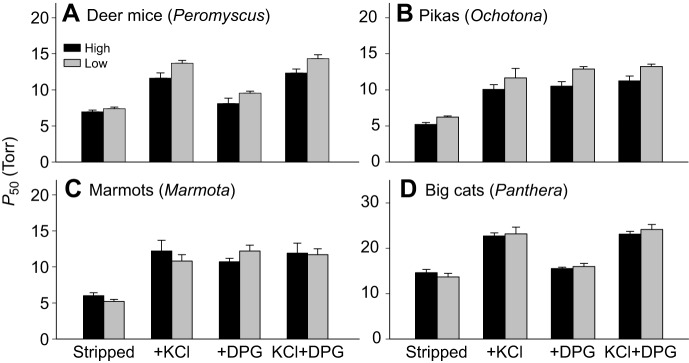Fig. 6.
O2 affinities of purified Hbs from representative pairs of high- and low-altitude mammals. O2 equilibria were measured at pH 7.40, 37°C, in the presence and absence of allosteric effectors ([Cl−], 0.10 mol l−1; [Hepes], 0.1 mol l−1; DPG:tetrameric Hb ratio, 2.0: [heme], 0.2–0.3 mmol l−1). For each taxon, P50 values (±s.e.m.) are reported for stripped Hbs in the absence of added anions, in the presence of Cl− alone (added as KCl), in the presence of DPG alone, and in the presence of both anions combined. This latter ‘KCl+DPG’ treatment is most relevant to in vivo conditions in mammalian red blood cells, but measurements of O2 affinity under each of the four standardized treatments can provide insights into the functional mechanism responsible for observed differences in P50(KCl+DPG). (A) Comparison between Hb variants of high- and low-altitude deer mice, Peromyscus maniculatus, from the Rocky Mountains and Great Plains, respectively [data from Natarajan et al., 2015a; for additional details, see Storz et al. (2009, 2010a); Jensen et al. (2016)]. (B) Comparison between Hbs of the high-altitude American pika (Ochotona princeps) and the low-altitude collared pika (O. collaris) (data from Tufts et al., 2015). (C) Comparison between Hbs of the high-altitude yellow-bellied marmot (Marmota flaviventris) and the low-altitude hoary marmot (M. caligata) (data from Revsbech et al., 2013). (D) Comparison between Hbs of the high-altitude snow leopard (Panthera uncia) and the low-altitude African lion (P. leo) (data from Janecka et al., 2015). For both cat species, P50 is shown as the mean value for two co-expressed isoforms, HbA and HbB, which are present at roughly equimolar concentrations (Janecka et al., 2015).

